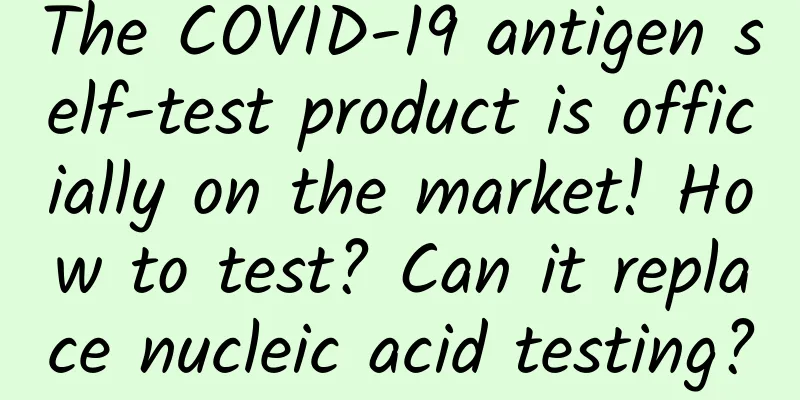The COVID-19 antigen self-test product is officially on the market! How to test? Can it replace nucleic acid testing?

|
Expert of this article: Wang Xiaohuan, Doctor of Medicine, Fudan University recent The news that the new crown antigen self-test product is officially launched Made headlines in major media Attracting a lot of attention But many people are also confused about this Antigen self-test kit How to do it? Who is it suitable for? Can it replace going to the hospital for nucleic acid testing? today Let's take a detailed look at it Come and see … Antigen self-test kit Can it replace going to the hospital for nucleic acid testing? Currently, nucleic acid testing is the basis for confirming new coronavirus infection. The antigen self-test kit is only a supplement and cannot replace nucleic acid testing. The principle of antigen testing is different from that of nucleic acid testing. Antigen testing uses protein fragments in the virus coating instead of genetic material (nucleic acid testing uses genetic material). After the viral protein in the sample is combined with the test paper with antibodies to the new coronavirus N protein (nucleocapsid protein, one of the important structural proteins of the new coronavirus), we can intuitively see the results in the corresponding test area on the test paper. To put it more vividly, if the new coronavirus is regarded as a suspect, antigen testing is equivalent to locking the target based on its appearance, clothing, etc., while nucleic acid testing is equivalent to locking the target through its fingerprints and DNA, so the "strike accuracy" of nucleic acid testing is higher. Combining molecular-level nucleic acid testing and immune-level antigen testing to give full play to their respective advantages can effectively shorten the detection window period, increase the positive detection rate, and provide double protection for various possible risk groups. How does the antigen self-test kit work? 1. Preparation before self-test: 1. Wash your hands; 2. Read the test instructions carefully; 3. Check the reagents to see if they are complete; 4. Confirm the testing environment and place the test paper flat in a clean area. 2. Sample collection: 1. Blow your nose with toilet paper, unpack the nasal swab, and avoid touching the swab head with your hands; 2. For sample collection, tilt your head slightly, hold the swab in one hand and place it into one nostril. Then slowly insert the swab backward along the bottom of the inferior nasal cavity for 1-1.5 cm, and rotate it in the nasal cavity for at least 4 circles (staying for at least 15 seconds). Then use the same swab to repeat the same operation on the other nostril. 3. Antigen detection: 1. According to the reagent test instructions, place the nasal swab for collecting samples into the sampling tube, rotate the swab head in the preservation solution for at least 30 seconds, and squeeze the swab head through the outer wall of the sampling tube by hand at least 5 times to ensure that the sample is fully eluted in the sampling tube; 2. Use your hands to squeeze the liquid out of the swab head through the outer wall of the sampling tube, and then discard the swab. After capping the sampling tube, drop the liquid vertically into the sample hole of the test card. 4. Interpretation of results: 1. Positive result: Both "C" and "T" show red or purple bands, and the color of the band at "T" can be dark or light, which are all positive results. (Photo provided by the author) 2. Negative result: A red or purple band appears at "C" and no band appears at "T". (Photo provided by the author) 3. Invalid result: No red or purple band is shown at the “C”, regardless of whether a band is shown at the “T”. (Photo provided by the author) 5. Test waste treatment: 1. Isolation observation personnel: Regardless of whether the test result is negative or positive, all items in the test kit after use (including sampling swabs, test cards, reagents, etc.) shall be collected and placed in a sealed bag and handed over to the medical management personnel of the isolation point for special treatment in accordance with medical waste or relevant procedural standards; 2. Community residents: Put the items in the test kit into a sealed bag after use. If the test result is negative, it can be treated as general garbage. If the test result is positive, the sealed bag should be handed over to the medical staff during transportation for special treatment in accordance with medical waste or relevant procedural standards. 6. Result response: 1. As long as the test result shows positive, regardless of whether or not you show COVID-19 related symptoms, you should immediately report to your community unit and be promptly transferred to a medical institution for nucleic acid testing; 2. If the nucleic acid test is positive, regardless of the antigen test result, the person will be identified as a COVID-19 infected person; 3. If only the antigen test is positive and the nucleic acid test is negative, centralized isolation and multiple nucleic acid tests will be taken. Who is the antigen self-test kit suitable for? 1. Patients who have experienced COVID-19 related symptoms (including fever, dry cough, fatigue, etc.) within 5 days of consultation; 2. Personnel in the quarantine observation period; 3. Other residents who have the need for self-testing. What situations may occur during self-testing? Antigen testing is different from PCR (polymerase chain reaction, a method currently commonly used for nucleic acid testing). PCR testing can amplify the target, so even if the level of viral RNA in the sample is low, it can be detected. Antigen testing, on the other hand, cannot amplify or amplify the target, which means that if the amount of virus in the sample is small (in the early stages of infection or when there are no symptoms), it may not be detected, resulting in misdiagnosis. A study reported that the accuracy of rapid antigen testing in symptomatic cases was 72%, and in asymptomatic cases of infection, the accuracy was only 58%. Among people who were not infected with the new coronavirus, rapid antigen testing could correctly rule out 99.5% of symptomatic people and 98.9% of asymptomatic people. Therefore, based on the current epidemic prevention situation, nucleic acid testing as the main method and antigen self-testing as the auxiliary method is indeed a more convenient, effective and accurate epidemic prevention strategy. The pictures in this article with the "Science Popularization China" watermark are all from the copyright gallery. The pictures are not authorized for reprinting. |
<<: Why do seats in public places have so many holes? Many people think wrongly
>>: Two poisons in one! Delta Chron variant confirmed for the first time
Recommend
Review | How did Douyin, which has been online for 500 days, compete with Kuaishou and Meipai?
The product was meticulously polished for 200 day...
Bullets are only nanometers in size! This may be the world's smallest shooting video game →
In a laboratory at Nagoya University in Japan, sc...
Taking Cloud Music as an example, how to acquire a large number of target users at low cost and high efficiency
How can we quickly acquire a large number of targ...
How can bidding projects obtain promotion information through multiple channels? (Part 2)
Continuing from the previous article "How to...
Audio
Source code introduction: Audio sound effects Aud...
How to write excellent promotional copy?
For many operations and promotion personnel, crea...
From C-end to B-end, my product design journey
I remember when I was interviewing for Lenovo'...
BMW China is unable to remit profits from China, rumor refuted by many parties
I believe most people know that the profits of jo...
I went to Kunming to drink tea and make an appointment at the authentic tea tasting place.
I went to Kunming to drink tea at a high-end auth...
Is it expensive to rent a small video server?
Is it expensive to rent a small video server? Now...
6 ways to increase the conversion rate of promotion pages by 30 times!
I once worked for an online education company. Th...
Baidu's Intelligent Driving Business Group changes leadership, Wang Yunpeng takes over to accelerate commercialization
Baidu recently released an internal email announc...
Using the AARRR model, let’s talk about APP operations!
The AARRR funnel model, also known as the Pirate ...
No matter how high-end the frankincense is, it doesn’t taste like milk.
At the beginning of the narrative, let us first c...
Thoughts behind the Nanjing electric vehicle fire: Illegal parking and charging continue despite repeated bans, so why do people always take chances?
The fire in a residential building in Nanjing cau...
![The 13th UI Zero-Base Advanced Course of Plum Superman will be concluded in December 2020 [HD quality]](/upload/images/67cc2bb9544c5.webp)








